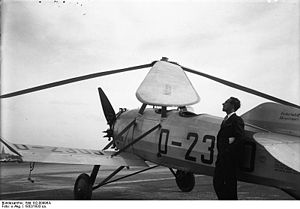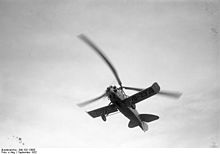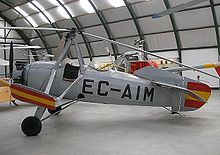Cierva C.19 Video - 1/4 Scale RC Model
|
|
Cierva C.19
C.19

Picture - Cierva C.19 Mk IV (Avro 620), D-2300 ex-G-ABUE, Avro c/n 5150
Role: Utility autogyro
Manufacturer: Cierva
Designed by: Juan de la Cierva
First flight: 1929
Number built: ;30
The Cierva C.19 was an autogyro designed by Spanish engineer Juan de la Cierva in England in 1929 and built by Avro which designated it their Type 620. A two-seat machine, it proved to be the most successful and widely-produced of the early Cierva designs.
Development
Cierva's first successful autogyro, the Cierva C.6 used an Avro 504 fuselage and this led to a long and close collaboration between Cievra and Avro from 1926 onwards, with Cievra providing the rotor design and Avro the airframe from designs that often appeared as both fixed-wing and rotary aircraft. There was a long series of such autogyros, developing the rotary wing concept. However the 1929 C.19 was a Cierva design, owing nothing to existing Avro aircraft, though it was built by them at Hamble.
Like the earlier aircraft the C.19 had a fairly conventional airframe, a two seat fuselage carrying a small span wing, bearing ailerons, to relieve rotor loads in level forward flight and a single radial engine in the nose. The unpowered, free spinning rotor had four wire braced blades or three cantilever blades in the Mk IV and was mounted on four struts over the forward cockpit which met together to form a pyramid. The C.19 Mk I - IV did not have the tilting rotor head and associated hanging control column of later autogyros like the Cierva C.30. Control was rather by the ailerons, elevators and rudder via a conventional column, a system that only worked effectively when the airspeed was high enough.

Picture - Cierva C.19 (Focke-Wulf C 19 "Heuschrecke") in flight
A major engineering refinement in the C.19 was the means to mechanically set the main rotor spinning; in earlier Cierva designs, the rotor had to be turned by hand or by pulling a rope unless there was space for a take-off run. In the C.19 Mk 1 this was done aerodynamically. The tail unit of this mark was a biplane structure with end-plate fins and rudders. To start the rotor the rotor, elevators and tailplanes were fixed in a near vertical position and the engine run up. The wash from the propeller was deflected upwards by the tail unit through the rotor, rotating it. This made the autogyro independent of ground crew at start for the first time, and private ownership a practical proposition.
The 80 hp (60 kW) Armstrong Siddeley Genet II made the Mk I machine rather underpowered and was replaced in the Mk II by a 105 hp (78 kW) Genet Major I. The Mk IIA, introduced in 1930 had a longer travel undercarriage and improved rotor head. Often landings were made at high angles of attack, so the rudders of the Mk III were reshaped to slope sharply upwards to avoid damage; this variant also had a 5 ft (1.52 m) increase in rotor diameter.
In the Mk IV the rotor was started directly from the engine via a clutch mechanism as in all future autogyros. This allowed the elaborate biplane empennage to be replaced by a more conventional monoplane tailplane. The single central fin was low to avoid the rotor and correspondingly of deep chord. The Mk IV had a three bladed, 34 ft (10.36 m) diameter cantilever rotor. The designation IVP was often used, the "P" standing for production which started in 1931.
The final variant was the solitary Mk V, G-ABXP. The aircraft style controls of earlier autogyros depended on airflow past ailerons, rudders and elevators; during the slow forward speed phases of take off and landing these did not work and accidents resulted. The Mk V lacked the small wing and all moving control surfaces, relying instead on a tilting rotor head. Using a long control arm which reached to the rear cockpit, the pilot could direct the aircraft by tilting the plane of rotation of the rotor. After a period of experimentation, the Mk V flew with a small fixed tailplane and a two-bladed rotor. This control system was adopted for the Cierva C.30.
Operational history
Some thirty examples were built in England, with licences acquired by Focke-Wulf to produce it in Germany (as the C.20) and by Lioré et Olivier in France (as the C.21) although no actual French production took place.
All 15 Mk IVPs appeared initially on the British civil register. One was used in an attempted fight to South Africa, though it only made it to Tunis. Later it flew with Alan Cobham's Circus. Another went to an autogyro flying school at London Air Park, Hanworth. Several machines were re-registered abroad: Australia, Germany, Japan, Singapore, Spain (one for the Spanish Air Force) and Sweden.
The Royal Air Force operated two C.19 Mark IIIs during the early 1930s for evaluation of the autogyro concept (serials K1696 and K1948).
Survivors
Non-flying
An Avro-built Mk.IVP c/n 5158 has been on display at the Museo del Aire, Cuatro Vientos, Madrid, Spain since 1968.

Picture - Avro built Mk IVP
Variants
C.19 Mk.I - The original three prototypes, powered by a 60-kW (80-hp) Armstrong Siddeley Genet radial piston engine. (3 built)
C.19 Mk.II - This variant was powered by a 78-kW (105-hp) Armstrong Siddeley Genet Major radial piston engine. The Genet Major engine was used on all further variants. (3 built)
C.19 Mk.IIA - Mk.II with improved rotor head. (1 built)
C.19 Mk.III - (6 built)
C.19 Mk.IV - The definitive production version, the basis for foreign licences. (15 built)
C.19 Mk.V - One-off experimental aircraft, tilting rotor head development machine. (1 built)
C.20 - Focke-Wulf licence-built version with Siemens Sh 14 engine.
C.21 - Lioré et Olivier licence-built version. (not built)
Specifications (Mk.II)
General characteristics
Crew: One pilot
Capacity: 1 passenger
Length: 18 ft 0 in (5.49 m)
Main rotor diameter: 30 ft 0 in (9.15 m)
Height: 10 ft 0 in (3.05 m)
Wing area: 708 ft² (65.8 m²)
Empty weight: 850 lb (386 kg)
Gross weight: 1,400 lb (635 kg)
Powerplant: 1 x— Armstrong Siddeley Genet Major I five-cylinder radial, 105 hp (78 kW)
Performance
Maximum speed: 95 mph (153 km/h)
Range: 300 miles (483 km)
Rate of climb: 500 ft/min (2.5 m/s)
Taylor, Michael J. H. (1989). Jane's Encyclopedia of Aviation. London: Studio Editions. pp. 254.
Jackson, A.J. Avro Aircraft since 1908. (1965) London: Putnam Aeronautical Books pages 433-5.
World Aircraft Information Files. London: Bright Star Publishing. pp. File 891 Sheet 29.
britishaircraft.co.uk
Cierva C.19 Pictures and Cierva C.19 for Sale.
Living Warbirds: The best warbirds DVD series.
Source: WikiPedia